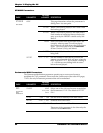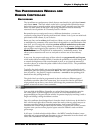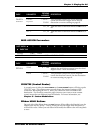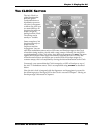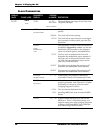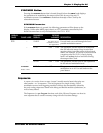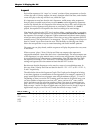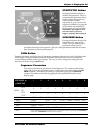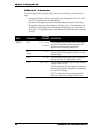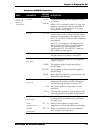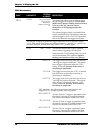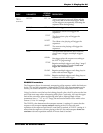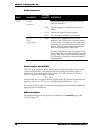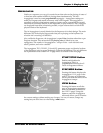
Chapter 2: Playing the A6
72 ANDROMEDA A6 REFERENCE MANUAL
Layout
Each of the sequencer’s 16 “steps” or “events” consists of four components or Levels:
a Note, the note’s Velocity amount, the note’s duration called Gate time, and whether
a note will play or the step will be a rest, called the Type.
It is important to note here that the A6’s Sequencer, unlike many other sequencers
that play their recorded notes when you press
START, can be triggered by numerous
sources. By default, the A6’s Sequencer runs when you play a note, and will play the
sequence in a key signature using that note as a reference. Likewise, if a chord is
played, the sequencer will sequence the chord according to its note settings.
Note that the values for the
NOTE Level can have either a positive value or a negative
value. This means that the sequence can play notes above and below the root note of
the sequence. For example, a sequence is often constructed such that it starts playing
when one note is played and held down. That’s the root note of the sequence which is
normally set to
0, the equivalent of “no transpose.” The NOTE setting for any Step can
then be “tuned” up or down from the root. This flexibility in allowing note values
below the root provides a way to create interesting and useful melodic patterns.
Of course you can play chords, and the sequencer will play the pattern for every note
in the chord.
When an event “plays,” Note, Velocity and Gate are output to the sequencer’s
assigned destination—most often the voices—simultaneously. The most common use
of the Sequencer is to play musical notes, so each event will generate a Note On (plus
its associated Velocity), then output a corresponding Note Off when the Gate Time
has expired. Of course, if
TYPE is set to REST, the Step will rest (the NOTE and VEL
settings are bypassed) for the amount of time that the GATE is set to.
But also note that the Sequencer can be used as a source in a modulation route. In
this case, Note, Velocity and Gate are listed in the
MOD SRC LIST as SEQ LEVEL A,
B and C respectively.
The table below shows the Sequencer Graph. The Graph can be thought of as being
in any time signature or combination of time signatures. For example, common 4/4
usage would yield four bars of quarter notes with downbeats at Steps 1, 5, 9 and 13.
Depending on how you set the
RATE setting and Gate times to fit into the song, you
can also consider a sequence as two bars of 8
th
notes, one bar of 16
th
notes, and so
forth. And since you can select the number of Steps, five steps of quarter notes can
play a bar of 5/4 and ten steps of quarter notes can play two bars in 5/4 with down
beats on steps 1 and 6. Six steps of eighth notes can play a bar of 6/8 and 12 steps of
eighth notes can play a two bars of 6/8 with down beats on steps 1 and 7.
STEP (or “EVENT”) ABCDEFGHI JKLMNOP
NOTE
••••••••••••••••
VEL (Velocity)
••••••••••••••••
GATE
••••••••••••••••
TYPE
••••••••••••••••



